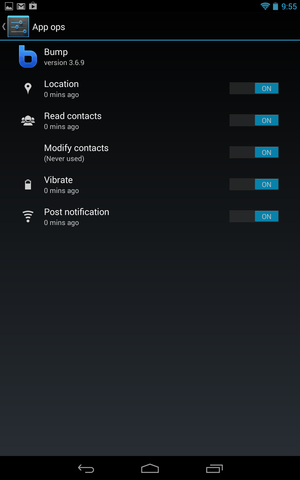already knew Android 4.3 focused on under-the-hood improvements, but it appears there are at least a couple more hidden features than let on.


As Android lice first discovered, Android 4.3 includes a hidden permissions manager, called “App ops,” which can prevent apps from accessing certain types of information.
This feature clearly isn’t ready for the average user, so has kept it well-hidden. You can find it yourself through any app that lets you view Activities, such as Nova uncher or Activity uncher. en looking through these Activities, look under Settings find the option for App ops. If that sounds too complicated, you can just download the rmission Manager app, which is simply a shortcut to this hidden feature.
Once inside App ops, you’ll see a list of all your apps, along with a granular list of their permissions. Tapping on any app lets you toggle those permissions on off. This could be useful if you don’t want an app to check for your location, but the app itself doesn’t provide a way to turn off location checking.
It is, however, a brute force tactic. The apps themselves won’t really know what’s going on when you’ve turned off a permission. If you turn off location checking, for example, the app will simply fail to find your location. It won’t show any kind of reminder that its permissions have been shut down. (By comparison, if you turn off G in phone settings, many apps will remind you that you need to turn it back on.)
so, as Android lice notes, some apps don’t show all of their permissions until you’ve actually used them within the app itself. In Bump, for instance, the permissions for “Vibrate” “st notification” only show up once you’ve opened the app tried to transfer something. As it sts, App ops could help for the occasional location-based permission, but it won’t be too useful for anything else.
4K for the future


Another intriguing hidden nugget, also discovered by Android lice, is support for 4K resolution. More specifically, the source code supports “XXXHD” pixel densities, going beyond those found in the sharpest-looking Android phones. “A typical use of this density would be 4K television screens—3840×2160, which is 2x a traditional HD 1920×1080 screen which runs at DENSITY_XHIGH,” says a note in the source code.
though there’s little need for a phone with higher than 1080p resolution, or a tablet with higher than 2560-by-1600 resolution, support for 4K could be useful down the line if 4K televisions monitors become more popular.
‘re going out on a limb here, but with Miracast support now built into Android, showing more interest in phone-to-TV controls with Chromecast, it’s clear that wants Android to play a bigger role in the living room. 4K support is of little use for Android now, but it might as well be in place for the future.


















